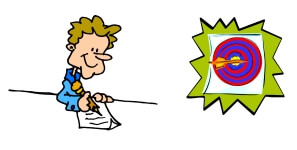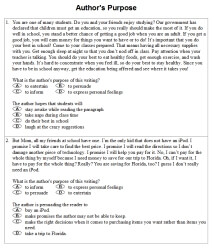
Worksheets and No Prep Teaching Resources
Reading Comprehension
Author's Purpose Worksheets
Reading Comprehension Skills |
Grammar |
Literature Units |
Graphic Organizers
Preschool | Kindergarten | First Grade | Second Grade | Third Grade | Fourth Grade | Fifth Grade | Sixth Grade
Preschool | Kindergarten | First Grade | Second Grade | Third Grade | Fourth Grade | Fifth Grade | Sixth Grade
A newspaper editorial about a new bike trail. Examples and facts about popular bike trails. A bike trail adventure. These three ideas represent pieces of the PIE-persuade, inform, entertain-the three main categories of author's purpose. Discovering an author's purpose helps students comprehend not only why an author writes but also how it is accomplished. Students of all grade levels will read a general article explaining author's purpose and then follow up by reading and identifying works of various lengths exemplifying pieces of the PIE.




